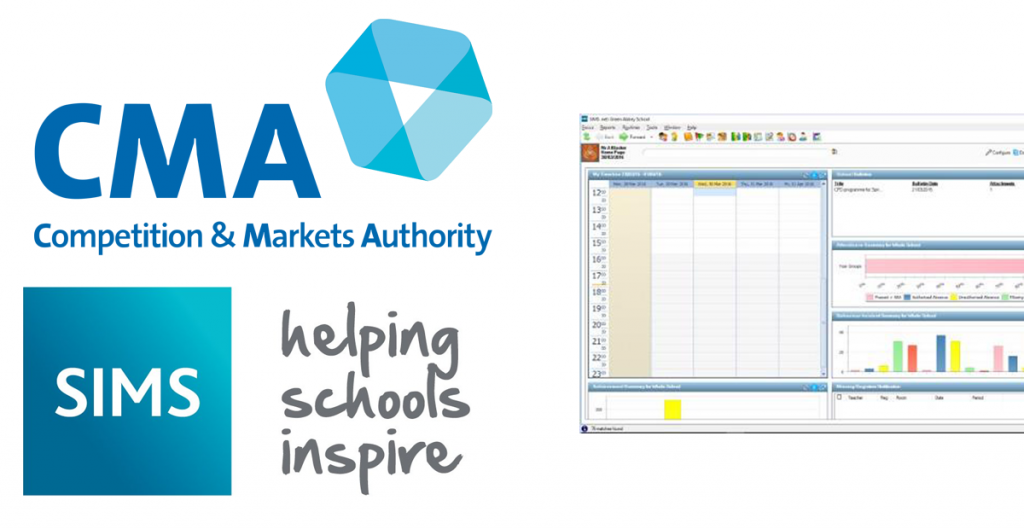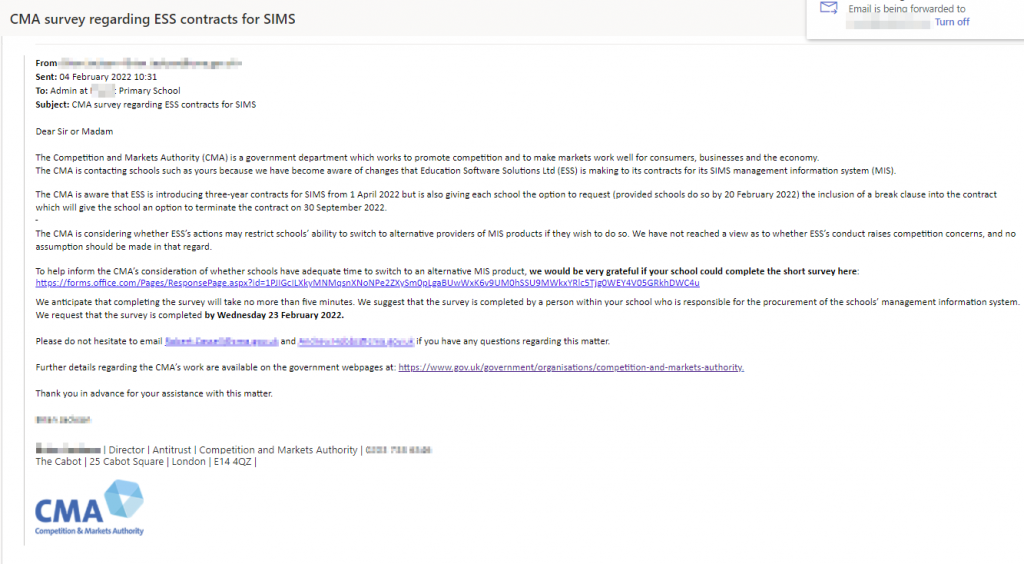Quick intro / disclaimer: we at SCG have relationships with a number of MIS software providers and we are neutral in this respect. Our work with schools wishing to change their MIS away from SIMS – the dominant provider over the last 20 years – centres around a requirements audit that we undertake on behalf of the school, and our process in this respect is transparent. We always declare any pre-existing supplier relationships, and pass-on any preferential fees that we are able to get to our schools.

It’s in our interests as a School IT Support Provider to help schools to make reasoned decisions, and not be pushed around by other providers. The recent goings on have made this very difficult, as schools are being backed into a corner by EES. Read on to find out why.
What’s the situation?
TL;DR: This morning we learned from one of our schools that the CMA (Competitions and Market Authority) are looking at the preliminary requirements for investigating EES in regards to this 6 month break clause and more widely the aggressive push to get schools to sign up for a 3 year contract.
We are as yet unable to provide any more information as contact has been made directly to a school and we would not wish to publish email addresses, but we have independently contacted and spoken with a Director within the Government’s CMA (Competitions and Markets Authority) to confirm the validity of this, so hereby we can vouch for this: here is the link for you to fill-in and tell the CMA what you think about the “abuse of dominance” that EES have in the market. If you feel similarly to us, please do fill in this form. We will update this post when more official information surfaces.
The world of UK Education IT is a pretty small one, and so we were grateful that The Register gave this matter a bit of an outing into the non-education-IT world in their article where they reported that the DFE advised schools to delay signing up to a new agreement.
Here’s the long and short of it:
Background to SIMS
SIMS has been used by a majority of state schools in the UK – both primary and secondary – for well over the 18 years that we at School Computer Geek have now been in the industry. SIMS stands for “School Information Management System” and as the world has progressed, the software has moved forward in leaps and bounds embarrassing jolts and starts. It started off life as a very basic bit of software thrown together by enthusiast teachers who thought “we really need to make school reports digital” back in the day when pupils’ and parents’ names and addresses were stored in filing cabinets. We’re talking the 1980s here.
Perhaps this was a laudable starting point, but things very quickly turned nasty as the local authority, Bedfordshire CC, took on its development and spent presumably hundreds of thousands on its development before passing the assets on to a private company. Perhaps it would be easy to turn a blind eye to these murky origins, where the public purse was effectively used to set up a private profit-making company, if it weren’t for how the story continued – and indeed continues to this very day.
SIMS then progressed – I say “progressed”, but really the software kind of grew in scope, trying but failing to keep up with the changing digital needs of schools in the late 1990s and early 2000s, when it became the mandatory piece of software required to help the government (starting before Blair’s government but certainly galvanised at that time) tighten up on its reporting of staff and pupils, through what we now know as the pupil and workforce census.
Nobody took a step back
Unfortunately for schools, the use of SIMS grew so quickly and so early, that even if there had been the motivation for a ground-up rethink of the way we hold data and ask schools to use it, this would have been a major upheaval for many schools. Nobody took the pain. Not to mention the strange tiered support arrangement which has been there from the start, whereby schools could only get support and training through IT support teams at local authorities – who incidentally shaped entire IT support functions around the need to provide this support to schools.
And like a lot of old software that nobody really gave enough love to – this software needs support. From a UX point of view, an information management system is admittedly one of the more complicated things that Joe average may be asked to use, on the other hand we live in a world where the average human being in a school can be expected to pick most IT systems up and work with them, with relatively low levels of support, this thanks to the revolutions in social media. (Nobody ever taught your Mum to use Facebook, right? Anyone should be able to pick stuff like that up, without needing a training course put on by the local council, Nescafe and Rich Tea Biscuits anyone?)
The Cottage Industry
Fast forward and today, many Local Authorities still have staff dedicated to the job of supporting this software package, many of whom sometimes – cynically – seem to take delight in how poorly designed the software still is, as it keeps their team in jobs – although gladly many have used their foresight and closed down such functions, passing the business on to the likes of companies like Turn It On, 3BM (now Strictly Education), SIMS for Schools, and others.
SIMS is still a beast of a piece of software, and I don’t use that word in kindness.
Many of the people who have had dealings in developing the software have promised all kinds of wonderful new innovations over the years – SIMS Gateway being one of the notable promises of modernisation that was supposed to allow the software to connect with parents, but there have been many others. A lot of us who have seen SIMS develop over a long period of time have become suspicious whenever the owner starts talking about a “new cloud based version” of SIMS.
Latterly, I contacted EES – the company incorporated in May 2020 to take over from Capita, who told me over the phone in November 2021 that they couldn’t say too much about it, but they were introducing a brand new cloud based service, which would be different to any of the previous attempts. After further quizzing, it was just a “SIMS installed on our end, we give you remote desktop connection”, much like many 3rd parties started to offer independently, for example SCOMIS. (Perhaps EES felt they wanted a piece of that “self hosted” pie. It really is a race to the bottom.)
On last count, one of our schools who moved over to a “self hosted” version allowing – shock horror – staff to access from home (!) underwent a lengthy onboarding process with no fewer than four organisations involved in the process (local authority, and three what looked to be private companies. Honestly I couldn’t work out who was who, and the school in question still seemed to think we were in control of the process despite – on this occasion – advising against it and being brought in at the last minute). Actually, if you count us – that’s a reluctant five! It is a cottage industry in every sense of the word.
Recent Ownership Shenanigans
Last year the CMA (Competition and Markets Authority) were brought in to investigate the proposed merger between Montagu and ParentPay (Montagu being a Frankfurt-based private equity firm) in respect to EES/Capita, and the decision was published in 2021, barely a year after Education Software Solutions (EES) in its current form was registered as a company. Shortly afterwards, ParentPay announced they had acquired EES.
More recently, and something that has set the alarm bells ringing in the vast majority of sensible schools in the country, EES appear to be pushing schools into a 3 year contract directly between EES and individual schools.
After a backlash to this from a good number of schools, EES directly contacted schools with carrots and sticks:
Carrots:
- The 6 month “Break Clause Offer”* (this is sneaky – see below)
- A “Beneficial Fee Structure”
- An amusing “£1 contract” which if it didn’t send shivers through spines would be amusing
- “SIMS Next Generation features” (don’t believe a word)
Sticks (all of this in the same email!)
- Increased prices of 25% to the LA if they don’t sign up to their “facilitation agreement” – this increase to be invoiced directly to the school
- If schools don’t take this up, they are reminded that they will not receive necessary updates required for this summer’s census and other statutory returns (what a lovely threat!)
* EES know full-well they are backing schools into a corner. They know that this break clause is almost impossible for most schools to take advantage of, because they still operate support contracts through the Local Authority. Every support contract we have been made aware of runs from April to April, which means that LAs have already (Feb 2022 at time of writing) started to seek to gain agreement for another year from schools. In reality, and EES must know this, most schools will end up having about one month to change their MIS. This is a completely unreasonable expectation.
Historically, and we are sure this does not apply to all LAs but we have seen evidence of it with a few, LAs also provide various carrots and some pretty nasty sticks, to ensure schools don’t move away from SIMS.
In the past we have seen various bundled services (i.e. the school would lose its internet connection if they cancelled SIMS support – yes really).
Only the more independent-minded schools, certainly Academies, seemed to express interest in moving away from SIMS.
What a mess!

